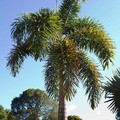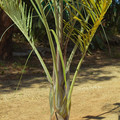Planted palms are generally very easy to maintain. They require little effort and only sufficient tender loving care. Some things to take care of include soil condition, leaf problems and brown tips.
Natural Browning
Before trying to solve browning in palms it is important to understand why palms go through a browning process. Basically, browning tips are natural. Palms produce new leaves throughout their growing period. As the plant reaches the end of its growth or life, its tips will start browning until it completely dries and then drops from the body of the plant. However, there are instances wherein browning is not just a natural occurrence.
When there are only one or two leaves browning and the rest of the plant and other leaves continue to grow then it is time to be concerned. There is clearly something wrong when the rest of the plant thrives while only parts of it do not. To properly address the problem, several steps need to be conducted for both diagnosis and treatment of the problem.
Determining the Problem
Initially, the first thing to do when there is an unusual browning in the palm is to examine the parts where the tips are brown. Try to see whether there is foliar tip burn or any damages to the roots. Some causes of browning in palms include excessive salt in the soil, over-watering and inability of the soil to drain properly or efficiently.
The next thing to do is to check for the fluoride level or toxicity. To do this, see if the tips of the palm leaf have dark brown colour. The problem can be caused by putting in too much fluoride in the palm's potting mixture.
It is also important to see the copper toxicity level in the palm. If the browning is caused by the increase in copper toxicity level, there will be brown elliptical spots by the tip of the leaf. Browning caused by copper toxicity also appears as if the leaf is suffering from a fungal growth.
Solving the Problem
Depending on the cause, there are many ways to correct browning and leaf problems in palms For instance, it is possible to stop browning and similar leaf issues by re-potting the palm into a different type of soil. Preferably, the soil should have free draining capacities. Also water the palm less when it is in the ground.
As for excessive salt content, leach the soil using water. Pour water into the soil and then allow the water to completely drain. Repeat this step around two to three times to lessen the salt content. Since the majority of browning and leafing problems comes back to the soil, it is best to replace the current potting mixture. Clearly, because the palm is suffering from browning tips, there must be something wrong with the components of the mixture.
Make sure to maintain soil pH within 6.0 and 7.0. Likewise, potting mixtures that have super phosphate should not be used. This can only increase the toxicity level of the soil further worsening the condition of the plant.
Another essential thing to note is to be aware of the fertilizers used to enhance plant growth. Some fertilizers and similar components added to the soil of the plant can only render the soil condition more fatal than helpful to plant development. Make sure to grow the plant as natural as possible.
<< Previous Palms: Fast Growers and How to Care For Them | Back to Mullumbimby Palm Blog | Next >> Palms:Sun, Water and Soil



